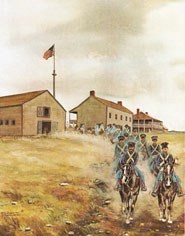
Dragoon soldiers from Fort Scott participated in many activities that contributed to westward expansion. They provided armed escorts for parties on the Santa Fe and Oregon Trails, surveyed unmapped country, and maintained contact with Plains Indians. Each summer, from 1843-45, several companies of dragoons, including Company A, 1st U.S. Dragoons, from Fort Scott, participated in military expeditions along the overland trails. The purpose of these expeditions was to protect travel and trade along the trails and to keep the Plains Indians at peace. 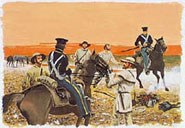
Trouble with Texans The first of these expeditions took place along the Santa Fe Trail - a trade route between Missouri and Santa Fe - then part of Mexico. The United States Dragoons, organized in 1833, had been charged with protecting the traders along the trail from Indian attacks. In 1843, trouble erupted along the Santa Fe Trail, not from Indian attacks but from Texans. Ill will existed between Texas and Mexico even before the Texan Revolution of 1836. Prejudice and hatred on both sides, border squabbles and violence continued into the 1840s. In 1843, Texas "freebooters" began attacking Mexican caravans along the trail. One group of Missouri men who had plans to join the Texan freebooters murdered Antonio Chavez, a Mexican trader, on American soil. The army apprehended and punished the killers but traders were fearful of further attacks and asked the War Department to furnish a military escort that year from Missouri to Santa Fe. 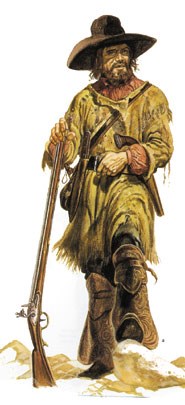
"We are not on American soil" Captain Philip St. George Cooke led five companies of dragoons along the Santa Fe Trail to protect the trade. In route, the dragoons encountered Jacob Snively, who held a commission from Texas to raid Mexican caravans on Mexican soil. Two days prior to their meeting with Cooke, Snively's men had attacked Mexican soldiers, killing several of them and taking their weapons. Upon their initial encounter, Snively's men and the dragoons were across the Arkansas River from each other. The land north of the river clearly belonged to the United States, but south of the river, U.S. territory only extended west to the 100th meridian. Snively claimed that he was forty miles west of the boundary, but Cooke contended that Snively was on American soil. Therefore, he ordered Fort Scott's dragoons under Captain Terrett, to cross the river and disarm the freebooters. The dragoons left the freebooters only ten guns for defense on their way back to Texas. A rumor persists that the Texans had hidden their own guns and surrendered the previously confiscated Mexican weapons to the dragoons. The 1843 expedition earned Captain Cooke the undying hatred of the Texans but was successful because it discouraged any further attacks along the Santa Fe Trail that year. 
Western National Parks and Monuments 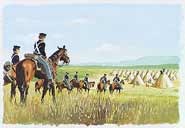
Dragoons on Patrol The year 1843 also saw the first significant migration over the Oregon Trail. To protect the emigrant traffic, the dragoons again went out on expeditions in 1844 and 1845. To strengthen security in the area and to end the fighting between the Pawnee and the Sioux, five companies of dragoons (including Company A from Fort Scott) traveled to Pawnee country in August of 1844. The next year, 1845, the dragoons met with the Sioux and other tribes during what is known as the South Pass expedition. One of the purposes of the expeditions was to impress the Pawnee and Sioux with the strength of the dragoons. The soldiers came armed with sabers, breech-loading Hall's carbines, pistols and two howitzers or cannons. The dragoons requested the Pawnee to make a truce with the Sioux and to refrain from horse stealing. The Pawnee, at first refused to comply. The dragoons left the Pawnee camp, but as they did so they fired their howitzers as a demonstration. The Pawnee were impressed. They remained peaceful for the next four years. The Sioux met with the dragoons near Fort Laramie in 1845. They were equally awed by the firepower of the howitzers. They thought that the dragoons were "a new and superior kind of white people." They agreed to leave the emigrant traffic alone, if the emigrants behaved themselves. 
"54º 40" or Fight" Colonel Stephen Kearney commanded the South Pass expedition. He led the soldiers along the Oregon Trail to Fort Laramie and then to South Pass, which they reached in June of 1845. This was the first time that an active U.S. military force traveled west of the Continental Divide. An unstated purpose of the expedition was to place a military force near Oregon in the event of war. The United States and Great Britain both laid claim to all of the Oregon Territory and were unwilling to relinquish. 54º 40" was the line of latitude that marked the northern boundary of Oregon Territory. The war cry "54º 40" or Fight", heard during President Polk's presidential campaign, reflected the desire of some Americans to control all of Oregon or go to war.r The threat of war with Great Britain must have loomed large in Colonel Kearny's mind as he awaited further instruction at South Pass. He waited one day and with no word of war, he and his troops began their return journey. Compromise had staved off conflict. The problem was solved by extending the existing boundary between the U.S. and Canada-the 49th parallel-to the Pacific Coast, which divided the Oregon Territory in two. 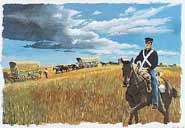
"A straight forward, simple and well-meaning people" While patrolling the Oregon Trail, the soldiers encountered several wagon trains heading west. This was of some concern to the dragoons because the teams and herds of the wagon trains consumed the grasses as effectively as a prairie fire, leaving little for the dragoons' horses. One dragoon officer praised the Oregon emigrants as a "straight forward, simple and well-meaning people." He reflected that the trip to Oregon would take a great deal of courage and perseverance. For the most part, the relationship between the emigrants and the dragoons was mutually beneficial. The emigrants enjoyed the dragoons' protection, while the dragoons enjoyed the attention that the emigrant girls lavished on them. Other pleasures of the trail included the scenery, the buffalo hunts and the welcome break from the daily routine of garrison life. The dragoons experienced the adventures of two trails in 1845. They returned via the Santa Fe Trail in order to escort the wagons heading east that year, completing a march of 2200 miles in just 99 days! The dragoons accomplished a number of things on their expedition. They gained valuable experience which would be useful during the Mexican War. They attained knowledge of the terrain and established friendly relations with many Indian tribes. They also made the trail safer for overland travel, which encouraged further westward expansion and contributed to the fulfillment of Manifest Destiny. Suggested Reading
Related Links |
Last updated: April 23, 2020
